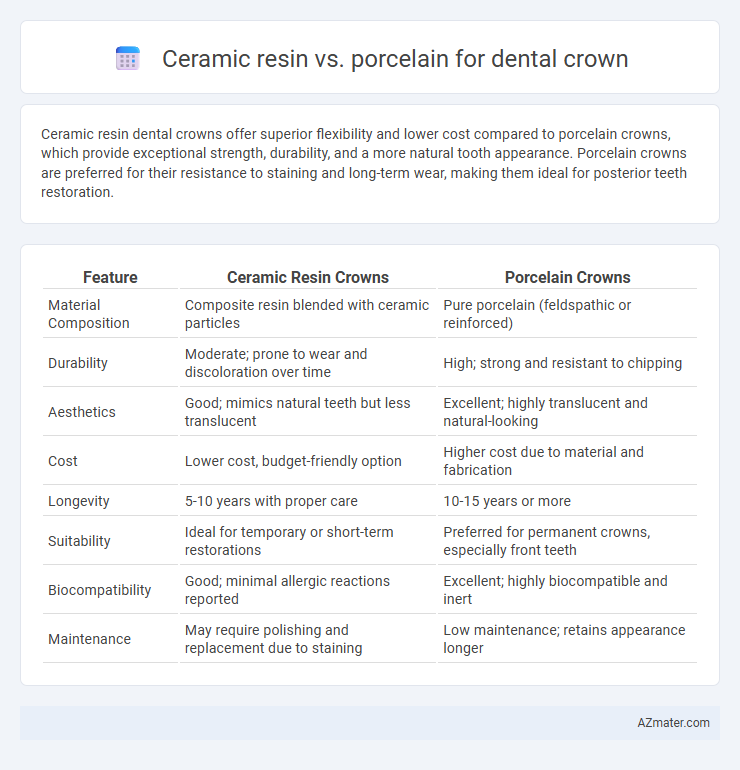Ceramic resin dental crowns offer superior flexibility and lower cost compared to porcelain crowns, which provide exceptional strength, durability, and a more natural tooth appearance. Porcelain crowns are preferred for their resistance to staining and long-term wear, making them ideal for posterior teeth restoration.
Table of Comparison
| Feature | Ceramic Resin Crowns | Porcelain Crowns |
|---|---|---|
| Material Composition | Composite resin blended with ceramic particles | Pure porcelain (feldspathic or reinforced) |
| Durability | Moderate; prone to wear and discoloration over time | High; strong and resistant to chipping |
| Aesthetics | Good; mimics natural teeth but less translucent | Excellent; highly translucent and natural-looking |
| Cost | Lower cost, budget-friendly option | Higher cost due to material and fabrication |
| Longevity | 5-10 years with proper care | 10-15 years or more |
| Suitability | Ideal for temporary or short-term restorations | Preferred for permanent crowns, especially front teeth |
| Biocompatibility | Good; minimal allergic reactions reported | Excellent; highly biocompatible and inert |
| Maintenance | May require polishing and replacement due to staining | Low maintenance; retains appearance longer |
Introduction to Ceramic Resin and Porcelain Dental Crowns
Ceramic resin dental crowns combine composite resin with ceramic particles, offering enhanced aesthetics and moderate durability ideal for front teeth restorations. Porcelain dental crowns are crafted from high-quality ceramic materials, mimicking natural tooth enamel with superior strength and stain resistance, making them suitable for both front and molar teeth. Both options provide biocompatibility and customization in color and shape, with porcelain crowns generally delivering longer-lasting performance.
Composition and Material Properties Comparison
Ceramic resin dental crowns consist primarily of a polymer matrix combined with ceramic fillers, offering enhanced flexibility and shock absorption, which reduces brittleness compared to pure ceramics. Porcelain crowns are made from feldspathic or leucite-reinforced ceramic materials, providing superior aesthetic translucency and hardness but lower fracture resistance. The resin-based composition grants ceramic resin crowns improved impact resistance and easier chairside adjustments, while porcelain crowns excel in mimicking natural tooth appearance due to their crystalline structure and high durability.
Aesthetic Differences: Ceramic Resin vs Porcelain
Ceramic resin crowns offer enhanced translucency and natural tooth-like appearance, making them ideal for front teeth restorations where aesthetics are paramount. Porcelain crowns provide superior color stability and resistance to staining, maintaining their brightness over time in both anterior and posterior applications. The choice between ceramic resin and porcelain hinges on balancing immediate lifelike aesthetics with long-term color retention and durability.
Strength and Durability Analysis
Ceramic resin dental crowns offer moderate strength and durability, suitable for front teeth due to their aesthetic appeal but may wear down over time under heavy biting forces. Porcelain crowns provide superior strength and longer-lasting durability, making them ideal for molars that endure significant chewing pressure. High-quality porcelain materials resist chipping and fracture better than ceramic resin, ensuring enhanced longevity in restorative dental applications.
Suitability for Molars and Front Teeth
Ceramic resin crowns offer excellent aesthetics and are well-suited for front teeth due to their natural appearance and translucency but may lack the durability required for molars. Porcelain crowns provide superior strength and wear resistance, making them ideal for molars that endure heavy chewing forces while still maintaining a lifelike look for front teeth. Dentists often recommend porcelain for molars and ceramic resin for front teeth to balance durability and cosmetic appeal.
Longevity and Wear Resistance
Ceramic resin dental crowns offer moderate longevity with good wear resistance but tend to wear down faster compared to porcelain crowns, especially under heavy biting forces. Porcelain crowns exhibit superior durability and higher resistance to abrasion, maintaining their aesthetic and structural integrity for 10-15 years or more with proper care. The enhanced wear resistance of porcelain makes it a preferred choice for posterior crowns subjected to significant chewing pressure.
Cost Comparison: Ceramic Resin vs Porcelain Crowns
Ceramic resin crowns generally cost between $800 and $1,500 per tooth, making them a more affordable option compared to porcelain crowns, which typically range from $1,000 to $2,500. The price difference is influenced by factors such as material durability, aesthetic quality, and lab fees. Insurance coverage varies, but porcelain crowns are often considered premium due to their natural appearance and longer lifespan, potentially justifying the higher investment.
Clinical Applications and Case Selection
Ceramic resin crowns offer enhanced esthetics and are ideal for anterior teeth with minimal occlusal stress, making them suitable for patients desiring metal-free restorations and natural translucency. Porcelain crowns provide superior strength and durability, especially in posterior regions where high masticatory forces require resistance to fracture and wear. Case selection depends on occlusal load, esthetic demands, and patient-specific factors such as bruxism, with ceramic resin favored for low-stress zones and porcelain preferred for long-term performance in high-stress areas.
Patient Experience and Comfort
Ceramic resin crowns offer enhanced flexibility and a more natural feel, resulting in increased patient comfort due to their ability to absorb bite forces and reduce tooth sensitivity. Porcelain crowns provide superior esthetics with translucency closely mimicking natural teeth but can sometimes cause more wear on opposing teeth, potentially affecting long-term comfort. Both materials are biocompatible and stain-resistant, yet ceramic resin crowns generally require less tooth reduction, preserving more natural tooth structure for a gentler treatment experience.
Maintenance and Care Instructions
Ceramic resin crowns require careful maintenance to avoid staining and chipping, with recommended practices including gentle brushing with non-abrasive toothpaste and avoiding hard foods. Porcelain crowns are more durable but still need regular flossing and dental check-ups to prevent gum irritation and fractures. Both materials benefit from avoiding excessive grinding or clenching through the use of night guards to prolong crown lifespan.

Infographic: Ceramic resin vs Porcelain for Dental crown
 azmater.com
azmater.com